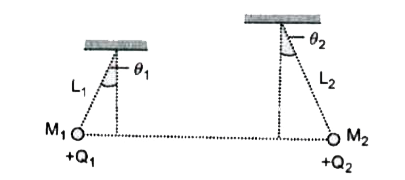The energy of a photon is equal to the K.E. of a proton. The energy of a photon is E. If λ1 and λ2 are the de broglie wavelengths of proton and photon, then λ1λ2 is proportional to :Solution in Kannada
E∘
E1/2
E−1
E−2
The correct Answer is:B
For photon Eph=hcλ2,λ2=hcEph
For photon Ep=1/2mv2=(mv)22m=p22m
⇒p=√2mEp
∴ for proton
λ1=hp=h√2mEp
But Eph=Ep=E
∴λ1λ2−h√2mE×Ehc=√E√2C
∴λ1λ2∝√3
Topper's Solved these Questions
- ELECTRONS & PHOTONSBOOK - MODERN PUBLICATIONCHAPTER - ELECTRONS & PHOTONSEXERCISE - MULTIPLE CHOICE QUESTIONS (LEVEL-II)
63 Videos
- ELECTRONS & PHOTONSBOOK - MODERN PUBLICATIONCHAPTER - ELECTRONS & PHOTONSEXERCISE - MULTIPLE CHOICE QUESTIONS (LEVEL-III)
9 Videos
- ELECTROMAGNETIC WAVESBOOK - MODERN PUBLICATIONCHAPTER - ELECTROMAGNETIC WAVESEXERCISE - RECENT COMPETITIVE QUESTIONS
4 Videos
- ELECTROSTATICSBOOK - MODERN PUBLICATIONCHAPTER - ELECTROSTATICSEXERCISE - RECENT COMPETITIVE QUESTIONS
39 Videos
Similar Questions
Maximum frequency of the photon produced by the union of a proton and a antiproton is (given : mp=1.67×10−27kg):
View SolutionEnergy required for the electron excitation in Li++ from the first to the third Bohr orbit is :
View SolutionThe speed of electromagnetic wave in vacuum depends upon the source of radiation
View SolutionTwo small spheres of masses M1andM2 are suspended by weightless insulating threads of lengths L1andL2 The spheres carry charges Q1andq2 respectively . The spheres are suspended such that they are in level with one another and the threads are inclined to the vertical at angles of θ1andθ2 as shown . Which one o fthe following conditions , if θ1=θ2 ?

View SolutionA proton has kinetic energy E = 100 keV which is equal to that of a photon. The wavelength of photon is lamda_(2) and that of proton is lamda_(1) . The ratio of lamda_(2)//lamda_(1) is proportional to
View SolutionA dye absorbs a photon of wavelength lamda and re-emits the same energy into two photns of wavelength lamda_(1) and lamda_(2) respectively. The wavelength lamda is related to lamda_(1) and lamda_(2) as :
View SolutionIf alpha particle, proton and electron move with the same momentum, them their respective de Broglie wavelengths lamda_(alpha),lamda_(p),lamda_(e) are related as
View SolutionThe matrix A=⎡⎢ ⎢⎣λ21λ1λ2λ1λ3λ2λ1λ22λ2λ3λ3λ1λ3λ2λ23⎤⎥ ⎥⎦ is idempotent if λ21+λ22+λ23=k where λ1,λ2,λ3 are non-zero real numbers. Then the value of (10+k)2 is . . .
View Solutionएक प्रोटोन तथा एक फरोतों की दी ब्रॉगली तरंगदैर्ध्य क्रमश: λ1तथाλ2 है। प्रोटोन की गतिज ऊर्जा तथा फोटोन की ऊर्जा (E) सामान है। सिद्ध कीजिएः की λ1λ2α√E
View SolutionThe wavelength lamda_(e) of ann electron and lamda_(p) of a photon of same energy E are related by
View SolutionThe energy of a photon is equal to the kinetic energy of a proton. If λ1 is the de-Broglie wavelength of a proton, λ2 the wavelength associated with the proton and if the energy of the photon is E, then (λ1/λ2) is proportional to
View SolutionEnergy of a photon = E , kinetic energy of a proton is also the same as energy of the photon. Corresponding wavelength of the photon and de Broglie wavelength of the proton are λ1andλ2, respectively. What is the relation between E and the ratio of λ1andλ2?
View SolutionWhen kinetic energy of proton is equal to energy of photon then ratio of de-Broglie wavelength of proton and photon is proportional to …..
View SolutionH- परमाणु तथा He+ में दो विशेष ऊर्जा स्तरों से प्राप्त फोटॉन की तरंग दैर्ध्य λ1 तथा λ2 है तो
View SolutionThe energy of a photon is equal to the kinetic energy of a proton. If λ1 is the de Broglie wavelength of a proton, λ2 the wavelength associated with the photon, and if the energy of the photon is E, then (λ1/λ2) is proportional to
View Solution
